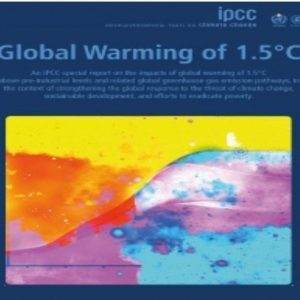
In 2015 the Paris Agreement, the global compact signed by the governments of the planet to tackle climate change, was agreed. In the negotiated process to reach this agreement some governments still had doubts about the degree of warming that was acceptable and necessary to maintain global development. These governments led by Saudi Arabia, asked the Intergovernmental Panel on Climate Change to undertake a special report on the impacts of global warming of 1.5 °C above pre-industrial levels. Recognising as we do that some increased emissions in developing countries may be necessary in efforts to eradicate poverty. This report and the summary for policy makers, based on review of more than 6,000 independent research papers was released on Monday 8th October at 3am UK time.
The report identifies that human activities have caused approximately 1.0°C of global warming above pre-industrial levels and if action isn’t forthcoming global warming is likely to reach 1.5°C by 2030. This warming is set to persist for generations even if zero emissions pathways were implemented immediately. The report indicates that current global challenges related to heatwaves in inhabited regions (high confidence), increased rainfall and flooding in several regions (medium confidence), and expanding drought (medium confidence). So the heatwaves, forest fires, tropical storms, flood and droughts aren’t going to go away any time soon.
Limiting global warming to 1.5°C compared to 2°C is projected to lower the impacts on terrestrial, freshwater, and coastal ecosystems and the biodiversity they contain (high confidence). Climate-related risks to health, livelihoods, food security, water supply, human security, and economic growth are projected to increase with global warming of 1.5°C and increase further with 2°C. So we need to act and we need to act now.
One existing opportunity is to link action to the delivery of the Sustainable Development Goals (SDGs). It has long been realised that tackling climate change is essential to deliver on the SDG’s. The graphic below illustrates the linkages between mitigation options and the SDGs, clearly demonstrating that our future is incompatible with continued use of fossil fuels.
Mitigation options deployed in each sector can be associated with potential positive effects (synergies) or negative effects (trade-offs) with the SDGs. The degree to which this potential is realised will depend on the selected mitigation options, the supporting policy and local circumstances and context. Particularly in the energy sector, the potential for synergies is much greater than for trade-offs, a reminder that we need to commit to zero emissions and need to act on this now.
Based on the stark evidence nations must now respond by signalling their intention to increase their national emission reduction pledges under the Paris Agreement. They have the perfect opportunity as this December the world gathers for the annual UN climate talks. We need to lobby our governments to take this report and its message seriously. They must commit to strengthen policies and actions that cut global greenhouse gas emissions, invest in measures to limit future climate risks, and do more to help communities cope with the climate impacts that are now unavoidable.